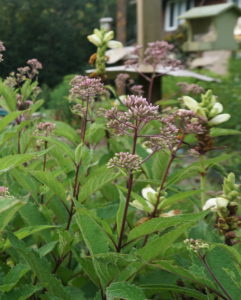 The White turtlehead, Chelone glabra, with its regal stems and inch-long, snapdragon like white flowers, should win a ribbon in any flower show. And a spot in most Piedmont gardens.
The White turtlehead, Chelone glabra, with its regal stems and inch-long, snapdragon like white flowers, should win a ribbon in any flower show. And a spot in most Piedmont gardens.
A great, late-summer bloomer, it flowers from August to October. The blossoms, which may be tinged with pink, combine well with Joe Pye, Eutrochium purpureum; False goat’s beard, Astilbe Biternata; ferns; and other plants
A favorite of butterflies, bees, and hummingbirds, they are a key host plant for the rare Baltimore Checkerspot Butterfly, Maryland’s state butterfly.
The White turtlehead plant ranges from 2 to 3 feet tall. They grow between 1.5 to 2.5 feet wide.
White turtleheads grow best in moist or wet soil. They are found in bogs, stream banks, and moist meadows. They like partially shaded areas but grow in sun if given sufficient moisture. (I grow mine in full sun next to a bird bath. When I fill or clean the birdbath, I give the turtlehead an extra splash.)
White turtleheads are herbaceous perennials, a type of plant that dies back at the end of the growing season. They reemerge in the spring. White turtleheads grow in zones 3 to 8.
The plant is not affected by any serious insect infestations or diseases. If the soil is dry and/or there is poor air circulation, they may be susceptible to mildew. If they grow in too much shade, they will need to be staked.
There are two other Turtlehead plants: Pink turtlehead, Chelone lyonia; and Turtlehead, Chelone obliqua.
The Pink turtlehead is native to the southeastern United States. Its flowers can be pink, deep rose or close to red.
Turtlehead, Chelone obliqua, has a rosy purple, pink or white blossom. Native throughout the United States, it blooms July through September.
Although these plants share similar names and qualities as the White turtlehead, they are sufficiently different that the Baltimore Checkerspot Butterfly does not use them as a host plant. For more about that Checkerspot, see the next blog.
The White turtlehead adds a refreshing touch to any late summer garden. Photos by Dave O’Callaghan
